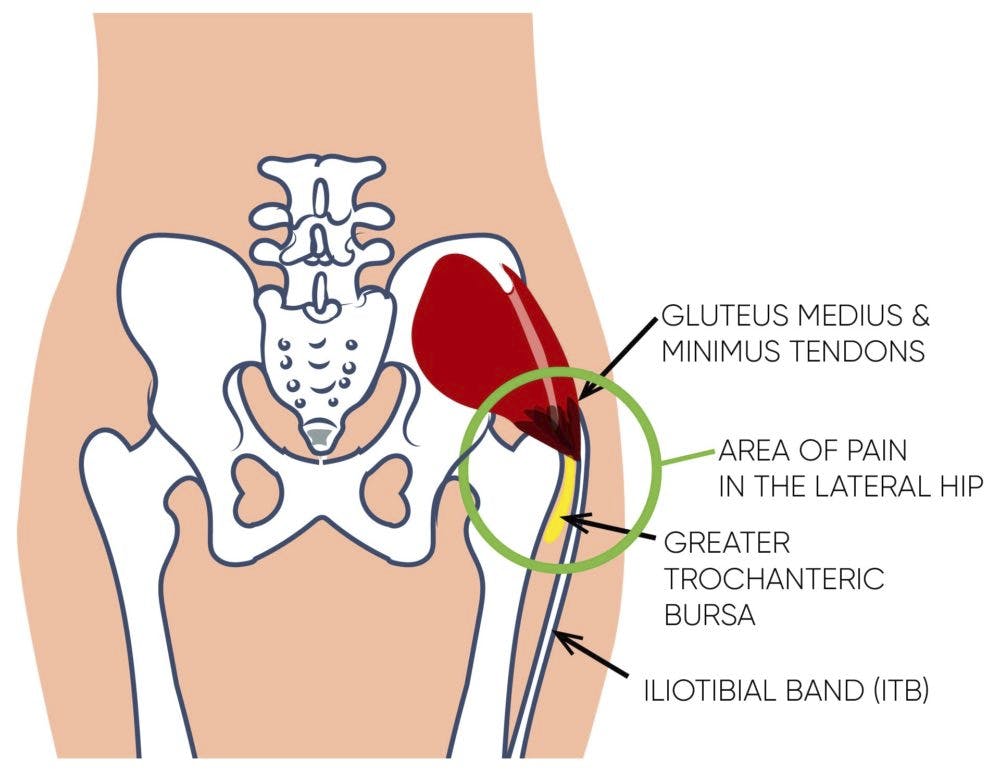Tendinitis of your glute tendons leads to pain on the outside of your hip. With gluteal tendinitis, hip pain interferes with your sleep, walking, climbing stairs, and many other functional activities. Approximately 10% to 25% of the population will experience this disorder. And 1 in 4 women over 50 years old develop chronic hip pain. This article shows you 5 helpful exercises that will help you overcome glute tendinitis.
What Causes Gluteal Tendinitis?

Gluteal tendinitis commonly occurs in sedentary people. However, it is also present in many athletes, especially runners. The condition begins with mild inflammation around your hip tendon and bursa. Many people are diagnosed with “hip bursitis” but the primary problem is your glute tendons. After a short period of inflammation, your tendon starts to weaken and break down. This leads to pain that worsens with time.
The problem begins when your glute tendons are loaded abnormally. Under normal activities and loads, your hip tendons will remain in a state of equilibrium. or even become stronger. Slightly increase your activity and load to your tendons, and they will respond by becoming stronger. However, when the load becomes too much, your tendons will start to break down. Also, the absence of any load (through inactivity) weakens your tendons leading to a progressive breakdown.
So to maintain strong and healthy tendons, you must regularly subject them to normal or slightly elevated loads. This is done through regular activity and exercise. Do too much or too little and your tendons will weaken. Then a cascade of events leads to chronic pain.
What Types of Exercises are Proven to Help Gluteal Tendinitis?
Fortunately, several types of exercise help. The key to any exercise program is, to begin with the right load or intensity. Then, your exercises must slowly progress to increase the load on your tendons. With consistent exercise, your tendon will become stronger and less painful. This takes time but it is your best long-term solution.
A 2018 study published in the British Medical Journal compared the effectiveness of isometric and isotonic exercise for people with glute tendon pain. Both programs consisted of daily home exercise for 12 weeks and 8 physical therapy sessions. Both programs lead to significant improvement after the 12-week program. The isometric exercise group reported a 19% decrease in pain. The isotonic exercise group showed a 17% decrease in pain.
What Specific Exercises are Best for Gluteal Tendinitis?
We recommend you do both isometric and isotonic hip strengthening exercises. Isometric exercises use static muscle holds usually lasting 6 seconds or more. Isometrics can be done lying down or standing (shown below).
Isotonic exercises are a more traditional approach where the muscle is lengthened and shortened in a slow fashion. Bridging, side-lying hip abduction, pelvic drop, and sit-to-stand exercises are examples of isotonic exercises.
Offset Bridging
Doing the glute bridge with your feet staggered slightly increases the load on your affected glute tendons. This is a great isotonic exercise to start with. Be sure to perform each repetition slowly. Concentrate on squeezing your glute at the top. Do 3 sets of 12 to 15 repetitions each day.
Weight-Bearing Glute Isometric Holds
This is a great isometric exercise, to begin with. Keep in mind that you will be standing on your affected side and lifting your unaffected leg. Hold for a minimum of 6 seconds (and up to 10 seconds). Concentrate on squeezing your glute and keeping your body straight. Do 3 sets of 10 to 12 repetitions each day.
Side-Lying Hip Abduction
Add this exercise after a week or 2 of doing the offset bridge. You must remain balanced and completely on your side. Do not allow your body or hip to roll back. Do 3 sets of 12 to 15 repetitions with both legs each day.
Sit to Stand + Band Abduction
Doing a squat or sit-to-stand movement with a band around your thighs loads your hip muscles and tendons. Keep tension on the band throughout the exercise. Move slowly and squeeze your glutes when you stand at the top. Do 3 sets of 10 to 12 repetitions each day.
Pelvic Drop
This is a more advanced exercise. We recommend you do the other 4 exercises for at least a month before trying the pelvic drop. To lighten the load, you can do the exercise without the step. It is ok to hold on to the wall or a chair for balance. Do 3 sets of 8 to 10 repetitions each day.
Your Physical Therapist Will Keep You on Track
Remember, any tendon injury is slow to heal. But the right exercises, in the right amount, will jump-start the healing process. When starting, it is better to go slow. Begin with the offset bridging exercise and isometric holds. After a few weeks, add in the side-lying and sit-to-stand exercises. If things are going well, in another few weeks add in the pelvic drop.

Be patient and expect some ups and downs along the way. But if you are consistent with your exercises, you will see significant improvement in 2 to 3 months. To become completely pain-free, other treatments will help. Manual therapy done by your physical therapist and specific stretching exercises will expedite your recovery.
For more help, call our office and schedule an initial evaluation with your physical therapist. The physical therapists at BSR have been helping people in Southern Ocean County move without pain since 2007. We are always here to help.

